“I woke up as the sun was reddening; and that was the one distinct time in my life, the strangest moment of all, when I didn’t know who I was – I was far away from home, haunted and tired with travel, in a cheap hotel room I’d never seen, hearing the hiss of steam outside, and the creak of the old wood of the hotel, and footsteps upstairs, and all the sad sounds, and I looked at the cracked high ceiling and really didn’t know who I was for about fifteen strange seconds. I wasn’t scared; I was just somebody else, some stranger, and my whole life was a haunted life, the life of a ghost.”
-Jack Kerouac, On The Road“I’ve been walking [San Francisco] for three decades… and now the place is layered with ghosts — of my own life, of the events of my lifetime, and of the histories that unfolded there before. Everything used to be something else.”
-Rebecca Solnit, “San Francisco: The Metamorphosis”
I am a person who cannot give up the ghosts. Everywhere I go reminds me of the last time I was there, and the time before that. Everything I do reminds me of the last time I did it, and the time before that.
I like to know the history of every new place I see, too. I want all the ghosts, not just mine, but yours too.

My Dad in Colorado, 1978. My parents grew up in the midwest (Dad in rural Ohio, Mom in Chicago) but lived in Los Angeles in the late ’70s, before moving back to Illinois and having me. They traveled a lot while they were in California, all over the Pacific Northwest and Southwest, and my Dad kept really meticulous photo albums. When I told my Mom that Abby and I were driving from California to the midwest she said that they’d done the same, in 1979.
For two weeks leading up to leaving, I packed. I organized and packed and packed and packed and organized and packed. This would be my 25th move in 33 years on this planet. Packing means unleashing hoards of ghosts, every time. You open a folder and ghosts tumble out, flimsy and worn, poorly packed, oddly labeled. For example, I have a folder called The Way We Were. I have another called The Case Against [Ex]. A legal-sized envelope with an ex-boyfriend’s name scrawled in all caps, red pencil.

In September of 1997, at 15, I’d left Ann Arbor to finish my last two years of high school at Interlochen Arts Academy in Northern Michigan. My father had died two years earlier and my Mom and I fought constantly and it was nice to be somewhere else. When I came home for Thanksgiving, I started crying the minute my Mom pulled off the highway onto Route 14, which’d lead us back into Ann Arbor. I held my best friend’s Billabong sweater to my face, inhaling his CK One, trying to transport myself back to where I’d just been, up north with my new friends. When my Mom asked me what was wrong, I said too many ghosts.
Wednesday, July 22nd, San Francisco to Anaheim

That moment when you pull out of your place and pull on to the freeway, your whole life in the trunk, is a strange one. I was just there! I was just inside that apartment six minutes ago and now I’ll never be inside it again, ever. You can’t imagine that your life will ever involve not sleeping in that place you just slept. Then a week later you can’t remember what it was like to be there, either.
This first leg of our trip — from the Bay Area to the Los Angeles Area — is one I know by heart, now. I know the rest stops, the factory farms, how quickly it gets too hot to breathe and then starts cooling back down when you curl on past Tejon Ranch. I know it like I knew the route from our house in Ann Arbor to my grandparents in Ohio, like I knew the route from Ann Arbor to Interlochen, like I knew the route from New York to Detroit when I lived in New York. But I’ve never driven south on this route without a plan to drive back north, soon. I feel relieved, if also twisted-up about how easy it’d been to leave, how few ties I have, like maybe I failed as a person out here, and maybe I’ll fail in Michigan, too. As I drive I think of every person I knew or loved or tried to know out here, making a mental list of things that were my own fault.
I’m in the scraped-and-dented maroon 2005 Prius I bought last summer and immediately drove to Oregon to sleep on the Orchard Abby was working at last year. She is in the grey Ford Ranger she bought last spring while planning the road trip from Indiana to California that was supposed to end with her returning home (Indiana), or going to school out East (Maine), but instead ended with her moving in with me in Berkeley. All in all, I spent five years in California and she did one. Now we are going home.

Anaheim isn’t on the way, of course, but Disney. We arrive in the evening, meet up with our friend Courtney, and head into Downtown Disney for dinner. Abby’s so excited she can hardly stand without jumping or touch me without squeezing my arm like a stress ball. Abby adapts popular songs to express her enthusiasm for tomorrow’s itenerary: Everything is DISNEY, Everything is COOL when you’re going to DISNEY!
After dinner we catch the fireworks and I remember tumbling out of Splash Mountain near midnight in Orlando, wet from plunging into the briar patch, with my then-girlfriend, Alex, and two of my best friends, one of whom turned out to be lying about everything including being able to afford that trip. We were so happy and the explosions in the sky were for us. What can I tell you: ghosts.

Regarding the construction of the Haunted Mansion, Walt Disney is quoted as saying we’re going to have ghosts from all over the world… but we haven’t got the ghosts in yet. We’re out collecting the ghosts.
I wrap my arms around Abby. I CAN’T BELIEVE WE’RE GOING TO DISNEY TOMORROW! She smiles, lighting up the sky. Our trip has begun.
Thursday, July 23. Anaheim, CA.

In addition to being older than Disney’s target demographic, I’m a good ten years older than my fiancé and the friends we’re Disney’ing with. This should matter but consistently does not. We meet up with Chelsey and Erin at 8AM for breakfast, and I make them describe the plot of Frozen to me as I’ve yet to see it and know it’ll figure prominently in the park. Then we meet up with Charlie and their friend who’s gonna sign us in.
They get Courtney’s Mickey hat wrong, wrote Countney instead of Courtney but it’s fine, it works, like when Abby yells “Countney, Count ‘Em Down!” and we each yell our numbers. I’m number five. We’re not really at risk of losing each other, but it’s nice to keep track.

I’m a total sucker for only a few things and one of those things is Disney. Abby is a sucker for a great many things but her thrill at meeting Mickey will only be rivaled by that of the children we take to this stupid wonderful place one day. It’s like doing ecstasy with your best friends, putting your love on blast. I am aware that Disney is a stylized sanitized saccharine monument to consumerism and I don’t care.

Disney holds up, again and again, meaning the ghosts aren’t at all intrusive but part of the fun: I’ve been to Disney parks with my family, with exes, with friends, and magically (so to speak), have exactly zero bad memories, and nothing wistful about the good ones. I guess it helps that I’ve had good fortune or strategy regarding cost. Like the $300 all-inclusive week in Florida I got in exchange for attending a series of workshops on owning time-shares in Kissimee St. Cloud. Or that friend who pretended to be rich, and paid for the whole trip. This time, the bargain comes courtesy of Disney employees (Courtney used to work at Disney, so she knows people) who can sign in a few friends a year.

While waiting in various labyrinth lines we discuss which Disney characters are the gayest and are very proud of ourselves for realizing that The Beast (as in; Beauty and The) is a butch lesbian. Beauty is the high femme who sees beneath the tough exterior and low-level dysphoria to awaken the prince within. Think about it.
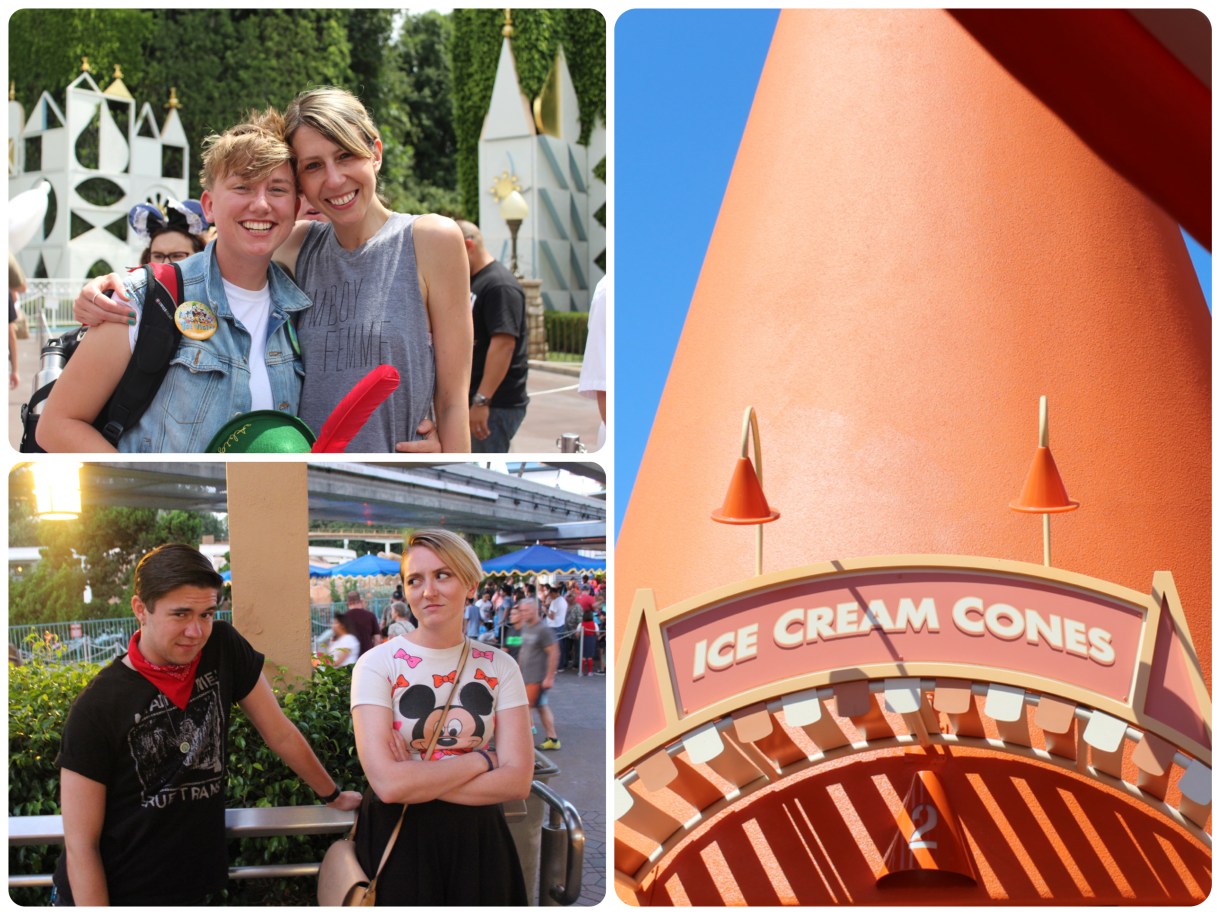
If one intends to pack their day with maximum Disney fun, I suggest attending with a former Disney employee. Courtney is a deft tour guide and Chelsey — not a former employee, but a clear descendent of Ariel the Mermaid and a former Floridian — is a handy first mate. Courtney ensures we pack as much Disney as possible into our Disney day. She knows the short-cuts, what gets crowded when, what to skip or not.

Charlie, Courtney, Me, Chelsey, Erin (Abby in the front)
All in all, we spend 17 straight hours in the park. Near midnight, our whipsmart strategic fun-maximizing is foiled when our path back to Thunder Mountain is blocked by the nighttime light parade. Abby and I edge towards the roped-off path and are quickly tugged aside by two girls whose tiara-ed heads barely reach my waist, dressed in full Frozen regalia, waving with desperate enthusiasm towards the SoCal teenagers hired to play their heroines in this particular section of park, who themselves are waving as generously as possible to nobody in particular. But then — but then! — Disney Light Parade Elsa and Anna spot the Mini Elsa and Anna next to me and both give them a specific, enthusiastic wave. The mini-thems completely lose their shit, like I imagine they will do one day for a YouTube star or whatever the equivalent will be, then. Our thrills come directly afterwards, careening down Thunder Mountain into a pitched, artificial darkness.
Friday, July 24th. Los Angeles, CA to Las Vegas, NV.
“The only problem now was a gigantic neon sign outside the window, blocking our view of the mountains…”
– Hunter S. Thompson, Fear and Loathing in Las Vegas
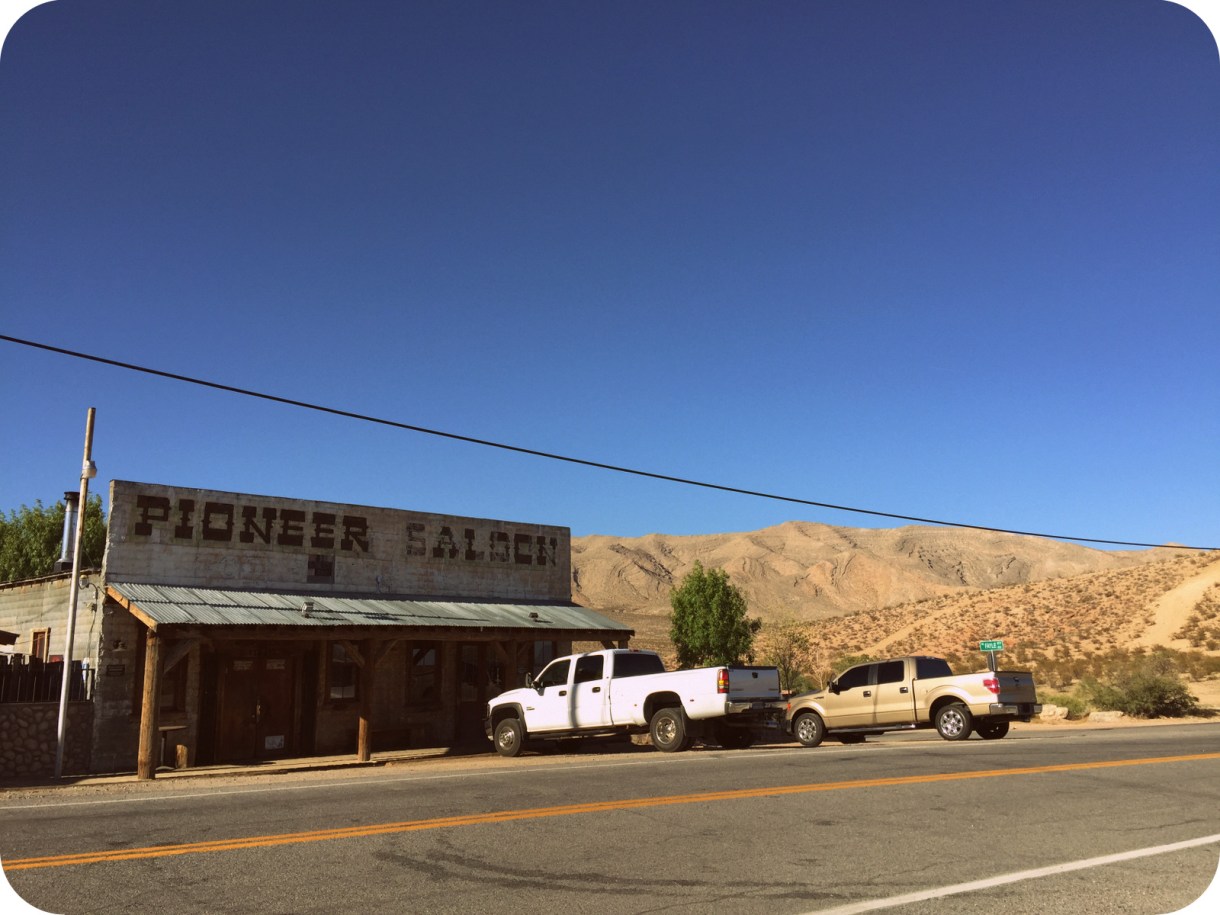
photo by Abby
Las Vegas exists ’cause it was a convenient stop on the railroad and then because of all the men who came out here to build The Hoover Dam in 1931. They needed a place to blow off steam. Back then, the casinos were called The Apache and the El Rancho. Now: The Luxor, The Bellagio, The Mirage, The Venetian, Ceasar’s Palace.
My first time in Vegas was 1995, a month and a half after my father died. We didn’t want respite or relaxation or anything that’d give us time to think, because thinking was sad. Vegas is actually very sad, but children don’t know that, and we were children. We grazed from one frigid maze of a casino to another, taking the yellow brick road through the MGM Grand, sleeping in a hotel designed like a Playmobil castle, gazing at Egyptian artifacts inside a 2,526 room pyramid-shaped hotel built two years earlier for $375 million dollars.
Later, I’d have a boyfriend whose legal guardians had retired in Henderson, and we’d visit. His great-aunt spent most of her days and nights drinking White Zinfandel and smoking cigarettes at the Arizona Charlie’s slot machines. Apparently there are no property taxes in Vegas, which’s why he wanted to move back after college, a desire I disregarded along with a laundry list of other reasons we weren’t right for each other.
Anaheim didn’t feel anything like “here,” it was still “there,” and so is Vegas. Vegas, where Alex, her friend Ryan and I spent a sweaty post-pool morning in 2009 hiking the strip on my demented mission to show them the Fall of Atlantis in Ceaser’s Palace, which was way less cool than I remembered it being. Vegas where then-girlfriend Marni and I went for “Shedonism” and I felt unpolished and uncool around our LA friends and we fled the Real L World-hosted party we were obliged to attend within five minutes of our arrival. Vegas, where on New Year’s Eve 2001 a boy said to me you know we’re gonna get married, right? and I pretended like I couldn’t hear him over the crowd and the fireworks.
Finding parking at The Rio is stressful, I feel tired and cranky and dead. Abby’s never been to Vegas but is already better at finding parking than me. I barely register the clerk telling me we’ve ben upgraded to a penthouse due to them overbooking the cheap seats. Okay, whatever. Maybe that’s how they describe rooms with king beds here. No but really: we’ve been upgraded to a penthouse.

When we reach the 20th floor and open the doors to our palace all we can do is go WHAT THE FUCK over and over, collapsing in laughter on the carpet, laughing more as we climb from the first floor of our suite to the second floor on a marble staircase and kiss against the pool table and visit the silver-set dining room and observe all three toilets and a bathroom bigger than our apartment with a double-steam shower and reader, I love a nice hotel.

When you really love someone like I love Abby, though, ordinary magic becomes downright witchcraft because on top of my own happiness and wonder is hers! I could ice a cake with it and I plan to. Do you know what I mean? And this girl, here’s the thing about her: she has been through some shit. Her life has not been easy. Yet she possesses a capacity for joy as enormous as my own for cynicism. Yes the word love has shifted in our hands but so has my understanding of what it means to be happy: I have known happiness but not like the happiness of being happy with Abby. You know what I mean, like how the best sex of your life makes you side-eye everything that came before. She one-ups my heart.
At the Bacchanalia Buffet at Ceaser’s Palace, I’ve eaten my first plate before Abby’s back from getting hers, so I go hunting and eventually find her wandering between sushi world and barbecue planet like Grandpa Simpson, her plate piled like a toddler you’ve just told can have whatever toys she can fit into a given small space. Abby’s diabetic (Type One) and her blood sugar is off, which means she got disoriented. Luckily there are lots of deserts nearby. We eat until we can’t eat anymore and set out to see The Strip.

We wander the humid, sweltering, packed strip streets, ducking into themed hotels, walking by at least two thousand youngish women in tube dresses and clunky heels, clutching each other in packs.
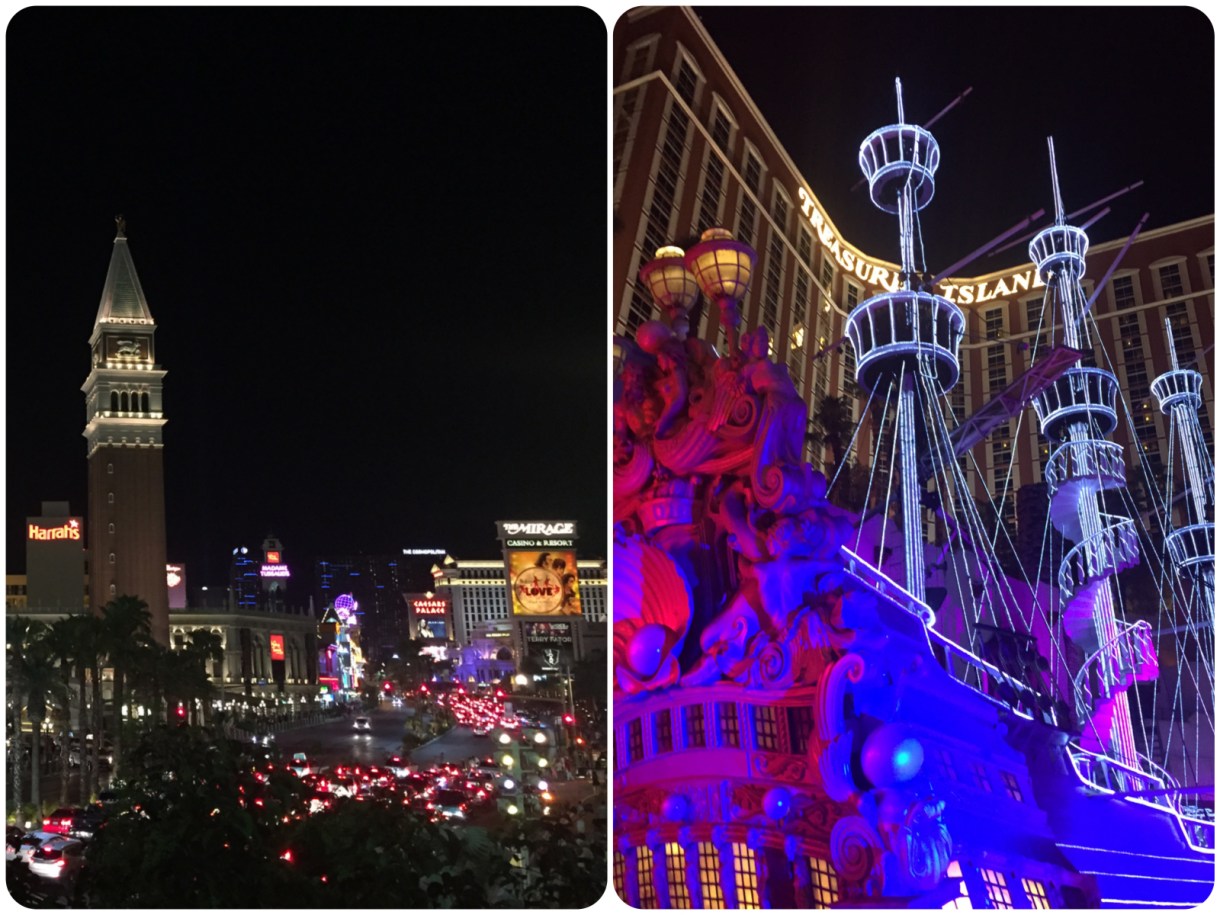
The walk back home is long and involves a significant stretch of broiling, sidewalk-free highway, but we sleep like queens.
Saturday, July 25th – Las Vegas to Moab, Utah
“Miners came to grab and get out, and they laid waste to their surroundings with gleeful abandon.”
– Rebecca Solnit, Storming the Gates of Paradise
Good fortune strikes early this morning, following a breakfast buffet easily described as “bad fortune”: the $100 we sink into slot machines, mostly Ellen DeGeneres’, nets $240.
Nevada is mostly empty. Almost all its residents are corralled in Vegas or Reno. Nevada is a place where you run out of gas not believing it’s possible that there could be so little civilization between here and there. Nevada is a site of extensive nuclear testing, of alien sightings, of mysterious military experiments. As we pass into Utah, signs of life increase, mostly.
We’ve given up on caravaning ’cause I drive like a normal person and Abby drives like she doesn’t want hamsters to feel insecure about their own capacity for speed. Instead we pick rendez-vous points. Our first is a ghost town named Frisco.

Named for the San Francisco mountains in which its mine resided, Frisco sprang up in 1875 when silver ore was found. By 1880 the town was on the railroad and boasted over 6,000 residents and a rowdy reputation, along with 23 saloons, a school, a local newspaper, hotels and churches. In 1885, the mine caved in. Some stayed behind, hoping for a twist of fortune, but by 1920, the town was empty.
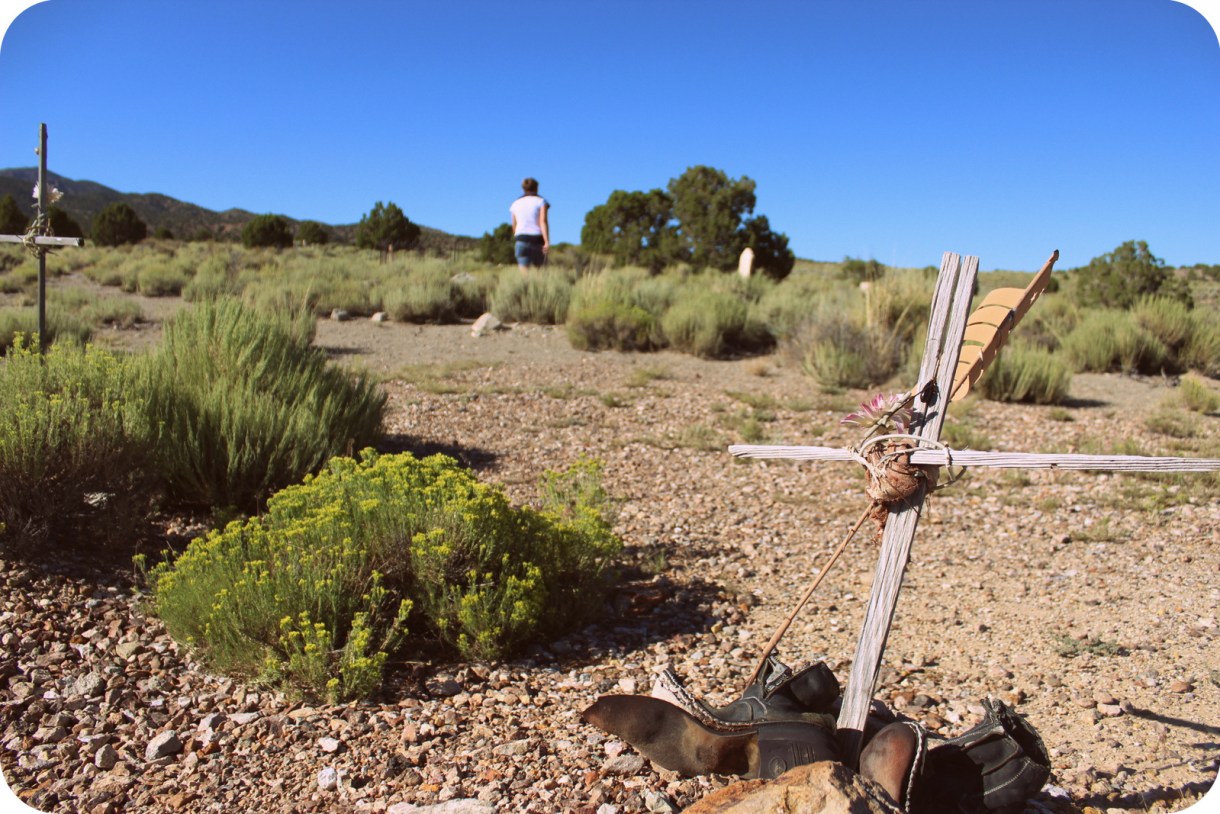
“The wildest town in the great Basin” maintained many of its structures out on this dry earth — charcoal kilns, mining equipment, a cemetery, what may have been houses. When we arrive a large sign warns us that the area has been “reclaimed” and we should beware.

So we find a way to walk back to the mountains without passing that sign.

Detroit is often described as a “modern ghost town,” or a ghost city, I guess, despite containing about 700,000 residents. You know: the blown-out abandoned houses, caved-in roofs, residential blocks with only one or two occupied units, miles of shuttered factories gutted for scrap metal, huge lots of urban prairies springing up where houses burned down. Growing up in Southeastern Michigan means growing up hyperactively aware of how industry builds and abandons communities and cities and the human heart, and I think my fascination with ghost towns probably began in Detroit. I can’t remember a time when I wasn’t drawn to them. But it’s tacky and grotesque, as a white person, to photograph the ruins of Detroit with the approach we take to photographing these abandoned mining towns. Those who mourn some kind of “golden age” for Detroit — the Paris of the Midwest! — ruined by the offshoring of factory work and the uprisings of the late ’60s ignore the fact that Detroit was only ever truly “golden” for white people, who’d started out terrorizing Natives (calling them savages, killing them, pushing them west in the ‘name of human progress’) and, once they were gone, moved on to terrorizing, segregating and incarcerating African-Americans. In Mark Binelli’s Detroit City is the Place to Be, a book I start reading out loud to Abby before bed, he writes of how Black residents endured years of “workplace discrimination, redlining, slum housing, and abuse at the hands of goon-squad cops,” and when white residents fled the city for the suburbs, they did so “not without sacking the joint on the way out the door” and “doing everything possible once they’d gone to ensure the failure of, and effectively place sanctions upon,” those left behind.
Driving through America means driving through ghost town after ghost town, so many that by the time we’d arrive at our destination, its poor turn of fortune would no longer seem exceptional. I knew this already from the State Routes we’d take to Ohio in the eighties which were already dotted with tiny, collapsed towns. We’re a country of fortune-seekers, inspired by an illogical belief in various prosperity gospels to chase booms like there’s never been a bust. Settlements converge around blind optimism, even in places like Frisco entirely devoid of water (they had to bring it in by rail.) The bust comes, and the people flee. Out west, everybody talks about the drought. In Detroit it rains a lot, but 40,000 residents just got their water shut off.
The Utah we go through is dry heat, a lot of orange, the memory of green. Very few towns but lots of enormous houses. An abandoned store, a church, another church, a Family Dollar, a trailer park, hay bales, horses. Whether a trailer or a mansion, though, one thing these residences all have in common is lots of space between them.
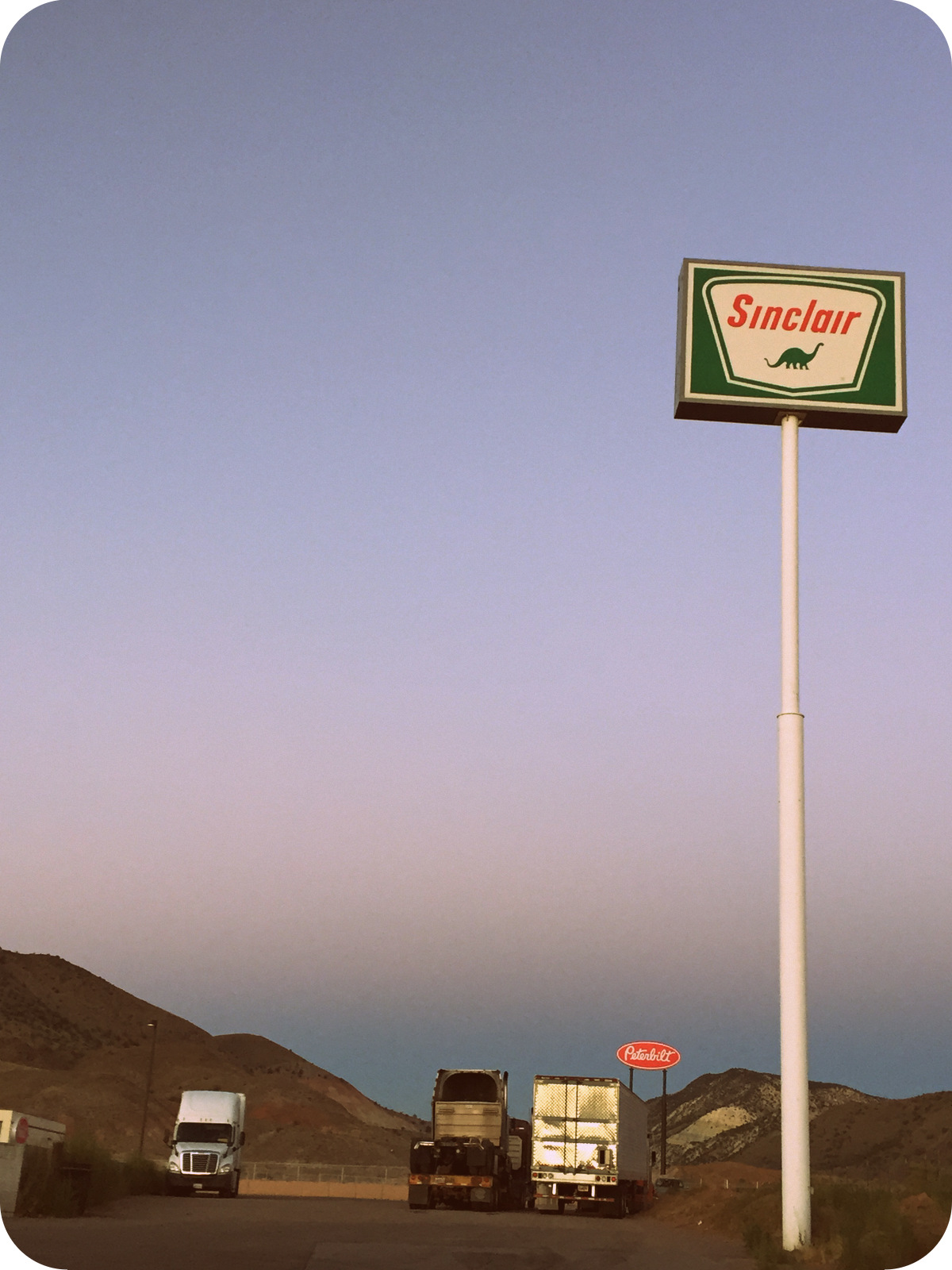
photo by Abby
This is when the trip begins something like a total re-orientation of the map, when you marvel, mile by mile, how many things you’ve yet to see. In California and New York, you start to feel like you’re at the center of the world ’cause you’re in the place that makes the movies or the magazines but no, you’re at the edges of the world, look at a map! They are spectacular edges, but there’s also a huge crater lake of life right here in the actual middle of it all. And I want to see all of it, every little thing, and with Abby.
For me this matters ’cause I’m a person who always wanted to be on those edges, to be “edgy” if you will. But the ratio of “fun things to do” / “ways to live” / “methods of being” to people who wanted to do / live / be them was like 1:2, so everything was very crowded. Everywhere else it’s more like 1:100. So like, I want to be somewhere less crowded.
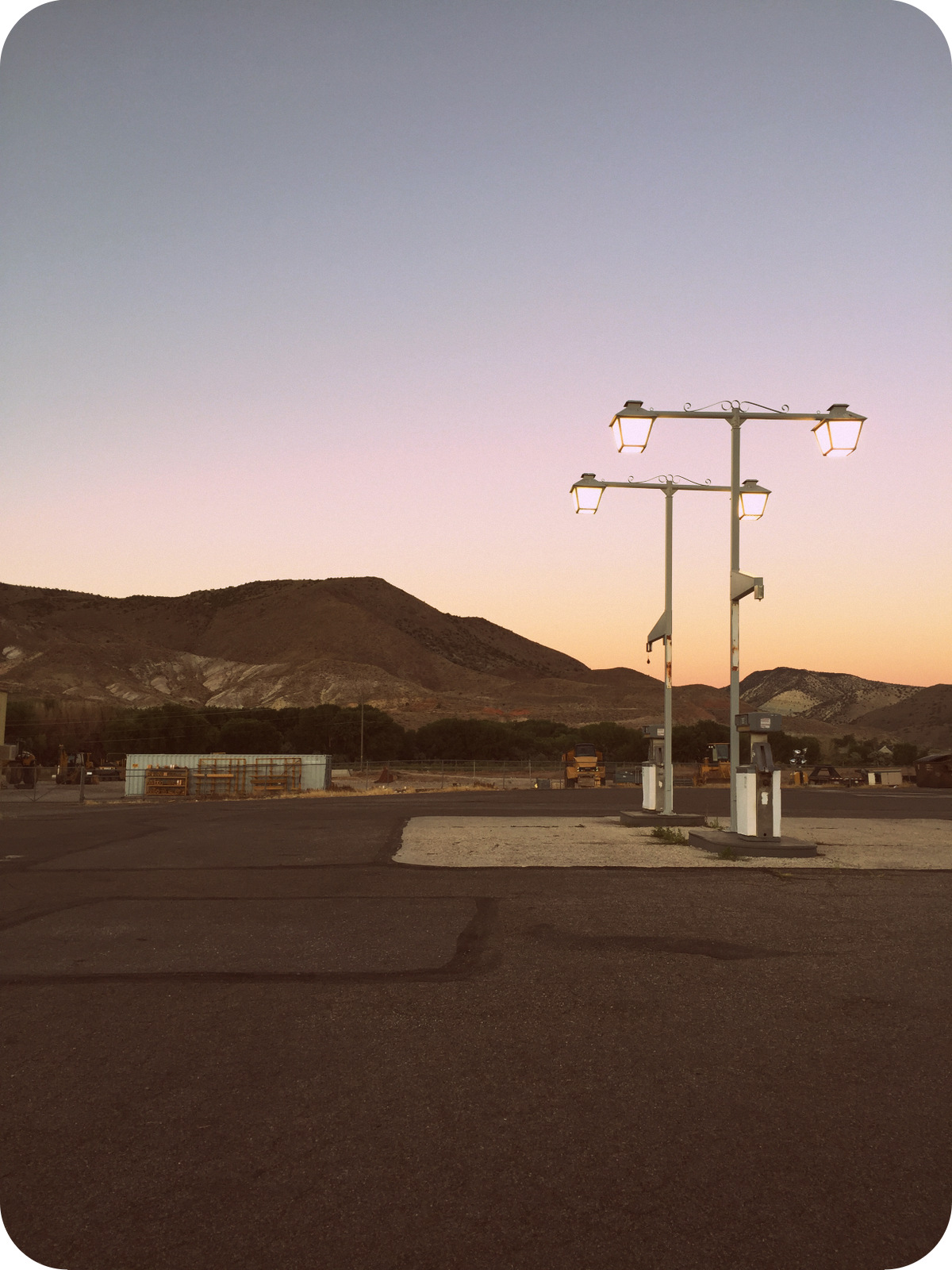
Gas Station, Utah (photo by Abby)
Sunday, July 26th. Moab, Utah.
“Kit Carson finds a book that tells of feats he never did. [Ahwahneechee activist] Jay Johnson finds a museum display that tells him he has vanished long ago. In the simulacral West, cowboys expand, Indians contract. “
-Rebecca Solnit, “The Postmodern Old West”

I’ve been to Utah a few times, I think, most recently in 2005, on an eight-hour Greyhound bus layover in Salt Lake City. I’ve been once in the winter, too. Abby says Utah, which she saw for the first time last year, is her favorite state. I can’t seem to separate it from its legends, specifically those of the Mormons, how nobody noticed anything out of the ordinary when they saw Elizabeth Smart out with her kidnapper.
Moab, once the Old Spanish Trail’s Colorado River crossing, is a town that got “built up” in fits and starts after centuries of prosperous inhabitance by Native Americans, followed by decades of wars between missionaries and Native Americans. Then white people found uranium here — and later, oil and gas — and that was the end of any kind of life for the Natives. Moab incorporated in 1902. When it came Utah’s turn for the railroad, though, they built tracks that bypassed Moab altogether, meaning traders had better places to cross the River. Due to that, it’d take another 40 years for the town to exceed 1,000 residents.

photo by abby
In the ’30s, one of FDR’s New Deal Civilian Conservation Centers got built here, created to provide conservation-and-development-related manual labor jobs to unskilled unemployed men. But in 1942 the building took on a new, more sinister purpose: it became “The Moab Isolation Center.” This is where the government sent Japanese-American internees from California who openly resisted or rebelled against the War Relocation Authority. This isn’t often mentioned in local tourism materials. But this is America, after all, blood and dust and the ghosts of men tortured in the name of ‘freedom.’

The Moab of today began its particular tale in the 1950s, when it briefly enjoyed the dubious title of “uranium capital of the world” and saw its population explode, doubling in size from 1950 to 1960, reaching over 5,000 residents in the late ’70s. The Cold War ended all that, and tourism became its main drag. A lot of Westerns have been filmed out here, apparently, which isn’t hard to believe because it’s beautiful, the kind of landscape that makes bad photographers feel like good ones. Maybe it makes bad movies seem like good ones, too. Western and action movies concoct endless situations in which belligerence is justified and admirable, writes Rebecca Solnit in “The Postmodern Old West,” in which a paranoiac autonomy is necessary.
Moab attracts a particular kind of tourist not uncommon in the Southwest: young, sunburnt men with long hair and four-wheelers or mountain bikes who jump off cliffs for fun. Also families, following guidelines to consume the recommended amount of water each day, wearing sensible shorts and hats. Even in Moab’s most crowded destinations, though — like the Island in the Sky — I already feel like we’ve got more room to breathe than we ever had in California.



We’re here because Abby’s got a high-level obsession with petroglyphs, the pictogram and logogram images carved into rock slabs thousands of years ago by ancient tribes. So we pick up a booklet called “Moab Rock Art” for $5.99 and set out to see them all. We both love to study recent history but Abby is definitely the ancient history buff. She likes things that are a little harder to figure out and also believes in aliens. So, I tag along, giddy by osmosis.

The sun rises over canyon country today just as it rose thousands of years ago when indigenous people chiseled images into rock, reads the introduction to”Moab Rock Art.” Like the sun, their inscriptions remain, reminding us that there was a time when people did not communicate via computers, cell phones and televisions.

Vandalism of petroglyphs and dinosaur footprints is a preoccupation of the Moab tourism industry, particularly the vandalism of the color panels at Courthouse Wash: In April 1980, it was discovered that someone had scoured the panel with common cleanser until the images almost disappeared from the rock.
Extensive passenger-seat research reveals exactly nothing regarding why anybody would want to wash away the panels. The Courthouse Wash panel is, then, very difficult to find, impossible to spot until you are literally steps away from it, and we only pass one other couple while on our hunt. We learn about rock cairns — tiny stacks of rocks indicating a trail. Only in the desert would such tiny monuments remain intact enough to be mentioned as useful guideposts in a seemingly timeless travel brochure.
We like looking for things and finding them, though, even when it leaves us sweaty and thirsty.

An hour before sunset we reach our second-to-last stop of the day, Arches National Park. There are petroglyphs at the base of the site and then a trail, marked and unmarked, from the parking lot up towards the fabled arches.

It’s getting darker. We walk up, past flocks of people walking down.

When you work at a computer all day every day, stretching your limbs like this feels amazing, putting one leg in front of the other until your car is too far away for words. We reach the final stretch in near-darkness, clutching a rock wall while dust unexpectedly rushes at our eyes. I’m shocked by the sting, like I was by the tear gas in Berkeley in what feels like another lifetime ago.
You can’t see the desert if you can’t smell it, Edward Abbey wrote in his famous screed about why people should get out of their cars. Dusty? Of course it’s dusty — this is Utah! But it’s good dust, good red Utahn dust, rich in iron, rich in irony.

So we lie on our backpacks and look at the arch with a few other stragglers or people spending the night.

When we spot a big family heading down we ask if we can tag along so we don’t get lost in the desert forever. (That’s the kind of thing we would do, undoubtedly.) They agree but we realize quickly that they don’t speak English and don’t have a flashlight. It’s fine, between the moon and our last dredges of iphone flashlight, we blaze our trail back to the car. We head out to look at the stars while trying to ignore the red CAUTION light flashing from my dashboard, and get home in two pieces.
Monday, July 27th – Moab, UT to Denver, CO
“But for us there was no wilderness, nature was not dangerous but hospitable, not forbidding but friendly. Our faith sought the harmony of man with his surroundings; the other sought the dominance of surroundings. For us, the world was full of beauty; for the other, it was a place to be endured until he went to another world.”
– Chief Luther Standing Bear
The auto mechanics want me to be very aware that they are not familiar with Priuses. I get it, I get it. Abby and I have a fight about nothing and wait for my car to get fixed while sitting on opposite ends of a curb encircling a road sign, then head out to the only remaining petroglyph site on our list, only half a mile from another abandoned mining town, Sego. Here, the petroglyphs are adjacent to the miner’s camp, an area whose fortunes dried up along with the water supply, resulting in a buyout that led miners to show up for payday after payday, never getting paid.

It’s jarring to see a carving from Cay Whipple, 1884, next to stories from centuries ago. One account of the area, from a miner named Water Ronzio, who’s father had moved to Sego in 1913 to work the mines, recalls “the children were fascinated by the many Indian petroglyphs engraved on the surrounding red rock walls, a veritable picture gallery.” This quote, from a 1970 book called Ghost Towns of the West, refers to those Indian tribes as “vanished,” as if they simply chose to leave and did so, or vanished like the area’s water supply, or the equipment destroyed by a series of fires in the ’50s. Of course they didn’t vanish. Then white people moved in, destroyed everything they could, and then chose to leave, and did so.

But Thompson Springs, Utah — the modern “town” closest to Sego and its petroglyphs — is its own ghost town, boasting a mere 39 residents on the 2010 Census. It’s unclear where they might live, if any still do, but we did see one elderly woman drive by the post office boxes to pick up her mail.

Thompson Springs got its name from E.W. Thompson, a sawmill operator, and prospered in the late 19th century as a station stop of the Denver and Rio Grande Western Railroad. Thompson Springs became a sort of community center for nearby farmers and ranchers, but really hit pay dirt in 1911 when commercial coal mining began in Sego Canyon. A railroad was built to connect the mines to the Thompson railhead, which was a tricky business from the start, due to a lack of nearby water and management problems.

Sego was ghosted by the demand for coal bottoming out in 1955, but Thompson didn’t start fading ’til the ’70s with the construction of I-70 and then the shuttering of the passenger train stop in 1994. Without travelers coming through on NV-128 or on the train, there was no way for the town to make money.

The train doesn’t stop here anymore, it just blows right past.

History is written by those who abandon, not those who leave a place the same or better than they found it.


Our next stop is Denver, basically a waypoint from here to there. My last trip to Denver was in 2005, after that eight-hour stop-over in Salt Lake City, which Krista and I had arrived at after a two-day Greyhound ride from Ashland, Oregon. We met a girl on the bus with bruises on her wrists and face who’d been assaulted by a friend she was visiting in Utah and was heading home to her boyfriend, who she said would give us a ride to our hostel. But when she called him from the station, he refused even to pick her up, demanding she walk a few miles to a more conveniently located hotel. We walked with her, heavy suitcases in tow. Was it okay, to let her go off with him? What could we do?
In my car I write I feel like a theme this trip is decay and rebirth. So much of this country has been left for dead.
We meet up in Glenwood Springs, Colorado, a busy tourist town on the river filled with things we wish we had time to do. Over burgers at the CO Ranch House we settle into a comfortable, fly-swatting silence. It’s hard to spend such enormous chunks of the day so far apart from each other in our individual cars. The days that are mostly driving are the hardest days, and the days where it’s just us seeing things are wild and awesome. We get books we don’t need at Book Train and meet up again outside of Denver to see some dinosaur tracks.


It’s past midnight when we get to our hotel in Castle Rock, which has a sign at the desk reminding us that even though the laws have changed, we can’t smoke marijuana here.
Tuesday, July 28th – Colorado Springs, CO to Kearny, NE
“I took many pictures on my visits to Detroit, but back home they just looked like snapshots of abandoned Nebraska farmhouses or small towns farther west on the Great Plains.”
– Rebecca Solnit, “Detroit Arcadia“
We drive to Colorado Springs to see the Ghost Town Museum, but it turns out to not be an actual ghost town, just an indoor situation behind a gift shop. So we head to The Manitou Cliff Dwellings, once the home of the Ancestral Puebloans. It’s pretty packed, mostly with children delighted by what must seem like world’s coolest treehouse.
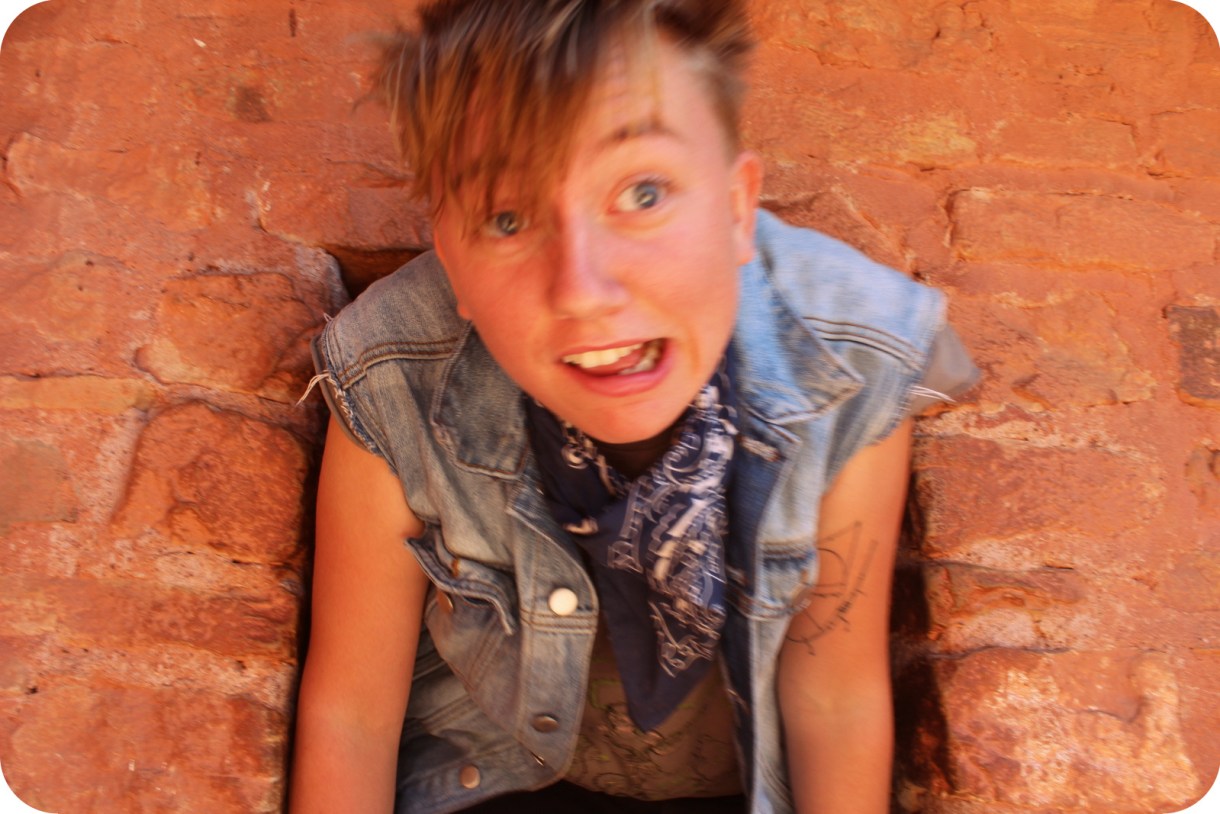
“Perhaps you can even ‘feel’ the spirits of the people who lived, worked, and communed in such spaces centuries ago,” says the guide map. I have a feeling if we could feel them, they would tell us to go back where we came from.

The site is impressive primarily for the size of their multi-story labyrinth gift shop. On our way out, Abby drops her phone about two feet and it shatters, immediately. We spend the afternoon going to the Apple Store, not getting an appointment, and then having a forgettable meal in the very cute downtown Colorado Springs. By the time we head out for Nebraska it’s already getting late.
The parts of Colorado we drive through seem positively wealthy compared to where we’ve been. Enormous houses, enormous churches, ranches dotted with horses. Everything seems new, and the closer we get to Nebraska, the greener everything is, too.

I don’t know much about Nebraska, besides that Conor Oberst is from Omaha and that Brandon Teena — the 19-year-old trans man raped and murdered by his girlfriend’s buddies — is buried just outside of Lincoln, and that his grave is hardly an adequate memorial to his life, reading, as it does, Daughter. Sister. Friend. There was a 1997 Vanity Fair article about Brandon by Joan Didion’s husband that discussed, briefly, how legendary Nebraskan Willa Cather kept her hair short and wore men’s clothing without much recourse, noting that The tyranny [Brandon] could not escape was less that of gender then of class, a prison more tyrannical than Willa Cather’s prairie town, especially in white America, where class distinctions are not supposed to exist. Abby, who grew up butch, queer and poor in Indiana, once said of her home, how long can you keep loving a place that doesn’t love you back.
Our identities shift with the landscape. In my late teens, my best friend Ryan’s boots made him gay in New York but almost the opposite — a cowboy — in Oklahoma. Now, Abby’s haircut makes her gay in California but something similar though not as sinister in the Midwest — an art student, maybe, or a feminist. Traveling while gay means new rules across each border, the rest stops where Abby will wait for me to show up and provide a live referral when her right to the women’s bathroom is inevitably questioned.

It gets greener and greener and greener and flatter and it feels like lying down! this sky though, I text Abby. I’ve never been here but already I can taste home, but then it just keeps getting darker and we’re a little lost, ’cause GPS doesn’t know about the construction happening here. We get to the hotel. They give us a room with two beds and we have peanut butter crackers for dinner.

Wednesday, July 29th – Kearny, Nebraska to Toledo, Iowa
I drug your ghost across the country, and we plotted out my death.
Every city and memory we whispered “Here is where you rest.”
-Conor Oberst, “The Calendar Hung Itself”
If we are going to just come out and be honest about it — about the bone and marrow of our ragshop hearts — we have no trouble deciding whether or not to have breakfast at Perkins.

In the daytime, Nebraska is just gorgeous, all rolling hills and farms and yes, the standard abandoned small towns, until we roll into Omaha, which looks, somehow, exactly like Indianapolis? The cashier at Kitchen Table seems like she could be our friend.

As we drive I catch myself grinning as my bones settle into the land beneath our wheels, wishing Abby was in the car with me so we could talk about farms.
Our next stop is Toledo, Iowa. We’re in Toledo for one reason only: The Designer Inn & Suites. Tama County contains Toledo and also the Meskwaki Bingo Casino Hotel, which boasts “the loosest slots in Iowa,” which I initially read as “the loosest sluts in Iowa,” and felt very confused.

The front page of the brochure for “The Designer Inn & Suites” invites travelers to “treat” themselves to “a night of romance.” It beckons with well-lit photos of various themed rooms, including but not limited to: The Heart’s Delight (heart-shaped tub, rose petals), Northern Nights (white and blue, Igloo themed, like being inside a Mallo Bar), Crystal Cave (lanterns, rock walls, very Fraggle Rock), Arabian Nights (racist) and Rainforest (our selection). We’ve been promised that “the moment you enter this suite, you will be instantly transported back to your own private Rainforest, with the exotic background and sound effects letting you know you have arrived.”
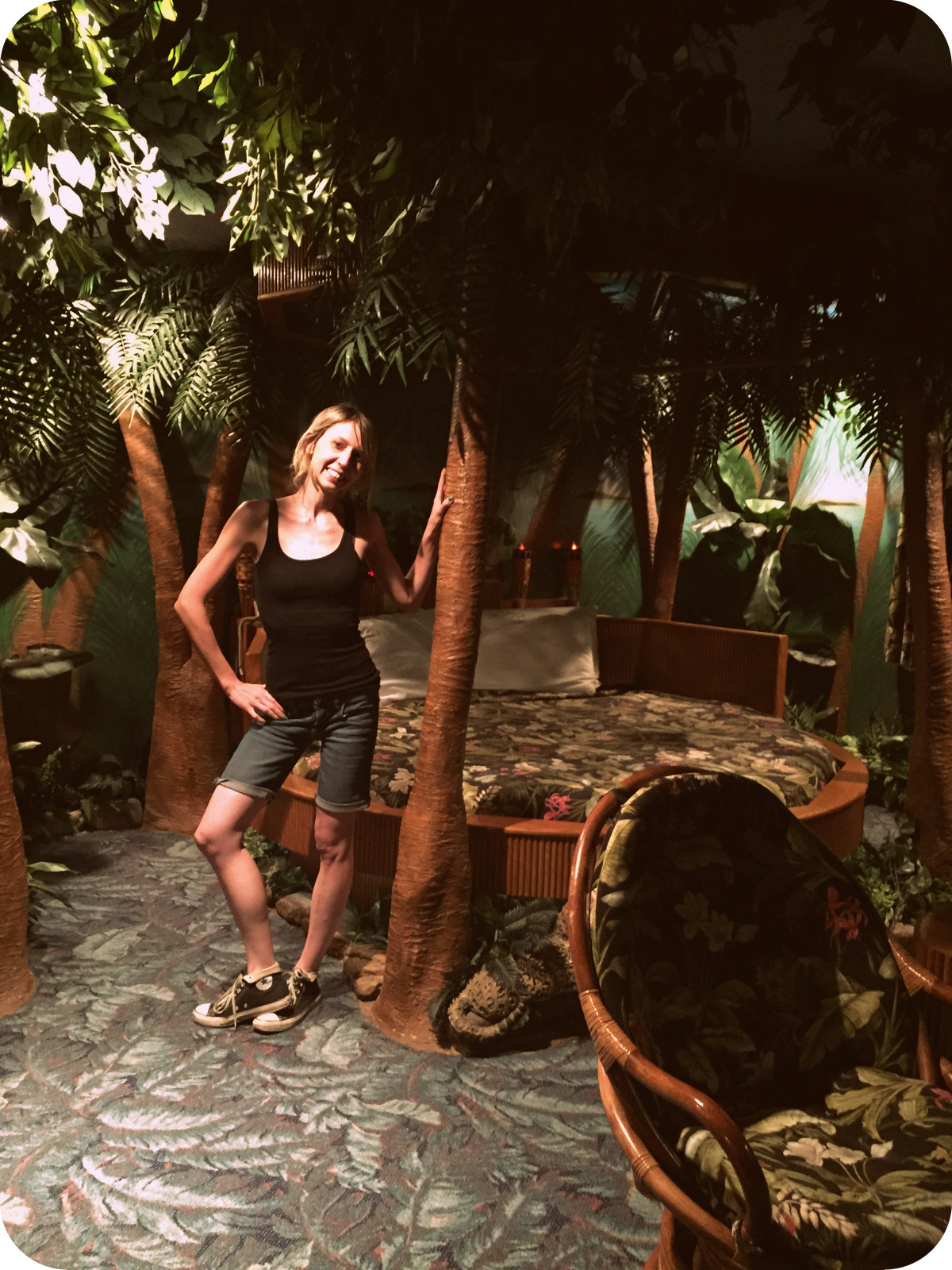
As advertised
One of our most severe regrets regarding California was that we never stayed at The Madonna Inn. We adore camp and kitsch and earnest Midwestern ideas about romance and whirlpool tubs. The room is painted to look like a jungle. A circular bed with a rainforest-themed comforter lies beneath a large circular mirror and a canopy of plastic trees and surprisingly not-dusty leaves. A larger fake tree overlooks the turqouise hot tub in the room’s far corner, with its trickling fountain and large puddle-shaped mirrors that make the tub look like a forest monster with a gaping mouth and huge, lopsided eyes.
All of this is the work of Gary Strobusch of Wisconsin, who bought the Toledo Days Inn in 2003 in hopes of creating multiple theme rooms like the singular ones he’d built for other hotels since ditching the custom-car business for the waterbed business and the theme-hotel-room-creation business. “Lying on the bed lit by tiki torches, guests spot birds and butterflies resting in the greenery covering the ceiling,” The Waterloo Courier said of our room in 2005. “Sitting in the whirlpool, people make out an orangutan etched into one of the surrounding mirrors.” YES INDEED.

We’re starving, though, and the nearest open vendor of food is, unfortunately, Wal-Mart, so we drive 45 minutes to get there, the ride in the dark feeling just like the ride from my Grandma’s in Reeseville, Ohio, into Wilmington, home of their closest Wal-Mart. On our way, I read to Abby about the cold case of Hellen Mae Brown, a 61-year-old resident of Tama County, Iowa, whose body was found in a river 24 days after she’d gone missing. “As I recall there was an idea that she had been drinking quite a bit at the time she disappeared,” said then-Tama County attorney Jared Bauch to the Tama Toledo News, “and her companions were rough customers.”

We talk about how dumb we are while soaking in the tub, eating cheese and crackers and drinking the champagne Alex and Mary gave us as an engagement present. I always wanted to stay in places like this as a kid. Dreams really do come true.
Thursday, July 30th – Iowa City, IA
I’ve never had a way with women
But the hills of Iowa make me wish that I could.
-Dar Williams, “Iowa”
Iowa City is just right. College towns always feel like home. Smart but too small to feel stuck-up. We’re too late to order from the breakfast menu when we get to The Bluebird Diner. You should stay another day to have breakfast tomorrow, the waitress suggests. We’d planned on driving to Chicago that night but well, we’ve already been there and we’ve never been here and if we stay we’ll have a big driving day tomorrow but a big nothing day today and that sounds nice, perfect even. So we have an afternoon squarely situated just far enough from There to feel absolutely Here.
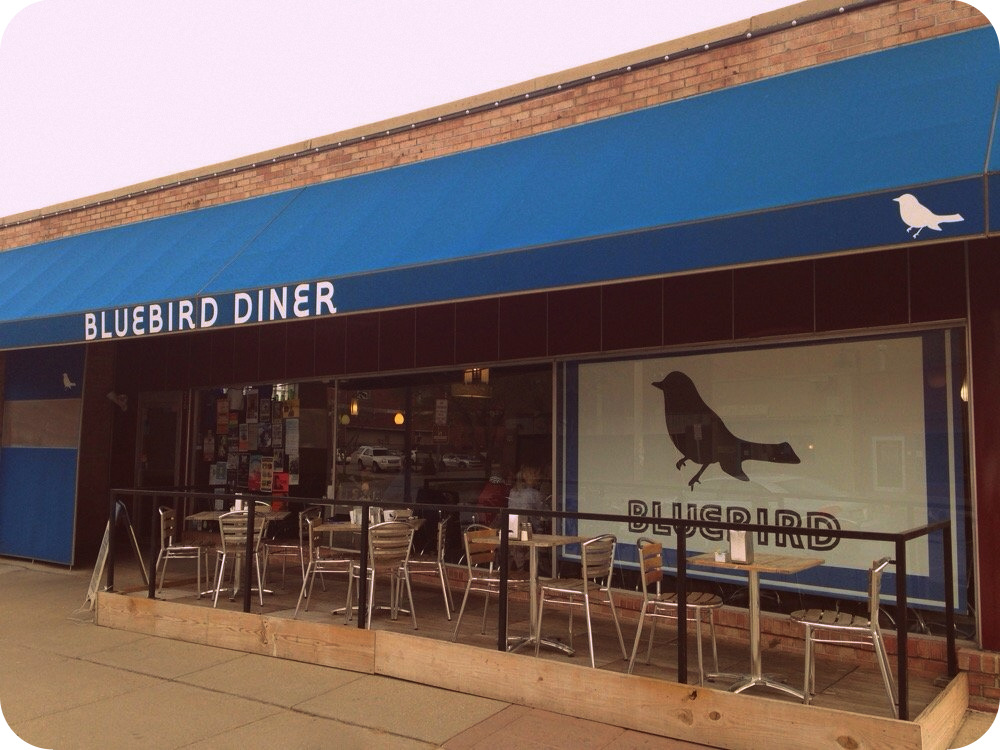
(photo via yelp because I forgot to take my own)
I’ve always wanted to see Iowa City, because this is where so many of my favorite writers lived and wrote and taught: most notably Raymond Carver, whose ghosts I have studied at length, but others, too: A.M Homes, Leslie Jamison, Thisbe Nissen, Stuart Dybeck, Mark Strand, Joy Williams, Kathryn Harrison, Sandra Cisneros, Michael Cunningham, Flannery O’Connor, Curtis Sittenfeld. But now that we’re here I can’t think of anything specific I’d wanted to see, besides The Prairie Lights Bookstore. I guess I just wanted to feel the ghosts. Everywhere he went that day / he walked into his own past, wrote Raymond Carver in “Where They’d Lived.” Kicked through piles /of memories. Looked through windows / that no longer belonged to him.
The Haunted Bookshop, named after Christopher Morley’s 1919 novel, has been in Iowa City since 1978, and we spend an hour or so there. Abby buys books about ghosts and aliens and I buy books about lesbians.

At Artifacts, piles of old magazines are shelved beneath stacks of old postcards, near shelves lined with vintage toys, telescopes, cameras, mugs, and a whole room of the kind of games my Aunt has in the basement.

“Our theme is if it’s boring, we don’t have it,” the owner of Artifacts told The Iowa Press-Citizen this summer on the occasion of its 20th anniversary.

Our waitress suggested checking out the Coralville Lake and The Devonian Fossil Gorge, a site of limestone bedrock and fossils over 200 million years old that washed up after the flood in 1993. So we do.

It’s hard to find the fossils but easier to find The Coralville Dam, in operation since 1958, which sits near a sprawling recreation area that reminds me of the Detroit-area metro-parks where we’d go as a family for wholesome fun and later as teenage idiots to get sunburns and drink crappy beer. We’re almost home!

We walk through downtown Iowa City. Abby likes to hook arms and lean into me, and then I’m the husband and she’s the wife. We have dinner at the Pullman Bar & Diner, buy comic books and drive back to Coralville to spend the night in the most ridiculous place possible at a “reasonable” price. That’s sort of the difference between Here and There. There are things I like about the unreasonable place, too. I miss things, of course I do. But I need something different now, something solid, something that had always been wonderful but I’d just never bothered to notice it. Something reasonable.
The Best Western Cantebury Inn & Suites invites you to “journey back to the days of yore” with its “unique medieval decor” “romantically decorated with Renaissance touches.” Our suite isn’t particularly medieval, save a school project style crest on the door. But it does include a heart-shaped whirlpool tub with track lights that, when turned on, give the room a distinct ’80s disco/bathhouse vibe that isn’t entirely off-putting.

We’re not ready for the trip to be over, but, well, it is. I read from Detroit City is the Place to Be until Abby falls asleep, and then I do, too.
Friday, July 31st. Going Home.
We set out early for the longest stretch yet, plowing forward into familiar country. On Saturday, we’ll have to take a U-Haul back to Chicago to pick up the Amtrak Express Shipment of our stuff (mostly mine).

When we finally cross the border into Michigan, everywhere is a place I’ve been. Towns with ghosts of my own. We stop for dinner at Cracker Barrel, my secret favorite. We used to meet up with our grandparents at the Cracker Barrel in Lima, Ohio (later, Glee would be set there, which never really added up), serving as a halfway point between Ann Arbor and Wilmington where my Mom could pass us off.
As we get further into the midwest we seem unable to resist the mating call of the crappy chain restaurants we grew up on. I couldn’t be in the midwest with someone who isn’t from the midwest, someone who can be very specific about their organic produce but also about their order at Steak and Shake. Who knows everything bad and terrible about this land and everything green and hopeful about it, too. Who wants our children to have a childhood not unlike the best parts of my own, where there are museums and parks and community theater and cities and country and all four seasons and maybe money left over to see the rest of this planet. We also both want land, and she wants to grow things on that land, just like everybody before us, the whole mess of ’em.

Before we left I downloaded this app, Roadtrippers, that I used throughout the trip. Roadtrippers is what I’ve never been able to make Google Maps do. You tell it your route, it tells you what’s along the way, and you select from surprisingly specific categories regarding what you’d like to see: Vegetarian & Health Food, Abandoned, Zoos & Aquariums, Offbeat Attractions, Swimming Spots, Public Art, Bed & Breakfasts — it’s buggy, but I’m sure they’ll sort that out soon enough. I use it now, even, just to find things one or two towns over if that’s where we’re going for the day. It’s odd that an app can do so much for how you see the world, but it honestly did, because it’s a great way to visualize how much stuff there is to do everywhere, how there are cool places to live everywhere.
There’s a reason we keep writing stories about driving across this country. This country is a blood-soaked disaster but the land we live on is beautiful, that’s a fact. It can also be terrible and spooky and yet many of us have this guilty, perverse attraction to its garbage, to its wild abandon, to what’s been left to rot in the desert so mercilessly, to freeze to death, to need rainwater or a drink of water. The problem in Detroit is not abandoned land, it’s abandoned buildings. Now, it’s rebuilding. It’s a rough customer. (Joan Didion was once told she was a “cool customer,” it haunted her.) Did you know the woman who wrote “America the Beautiful” was a lesbian? A Tripadvisor review of the Camelot-themed hotel we liked in Iowa City reads: They had theme rooms of the King Arthur period of history which were so neat. Last year they rid of those. I knew it was going downhill then.
We arrive in Royal Oak, the Detroit suburb my Mom moved to while I was in college, late, to her house, which I’ve never seen before. We go to bed right away so we can get up early and head out for Chicago in the morning to pick up the boxes.
I spend the next few weeks giving Abby tours of all my ghosts, one story slapped over another, like Eberwhite, where I spent my first three years of elementary school, and then, where the whole neighborhood came together to build a playground, and then, where, in 2003, after a nasty, heart-ripping feud with my not-boyfriend, I’d driven and parked but left the car on, hoping it’d eventually run out of gas, leaving me stranded. I’ve got no idea why I thought that was a good idea or even an idea at all? I was very stupid that year, I mean, really truly stupid, and frustrated by the landscape’s lack of stupid choices to make that didn’t involve prescription drugs. I guess I wanted something certain to happen, a set of circumstances to align themselves in a way that’d limit me to a definitive set of options for what to do with the next minute or hour, like “getting my car towed.” I don’t know why I chose Eberwhite, either. I waited for hours but never ran out of gas. At some point I must have just gone home.
I show Abby where I got caught ditching class the only time I ever ditched class, The Macaroni Grill where I worked through college, the house I grew up in, the houses I lived in, later, in undergrad at University of Michigan. I show her the crumbling, filthy fraternity house in nearby Ypsilanti where I gave away my pride like a cup of punch. The hill where we went sledding, the spot in the diag where Bianca pulled my pants down, the deli all the cool kids worked at. One morning, we get a tour of Detroit from somebody who has lived there a long time and knows everybody, really, absolutely everybody. We keep reading. Abby gets a job, I set up an “office” at the kitchen table using what I think is bathroom-oriented furniture scavenged from the basement. It’s a huge adjustment to live with my Mom after spending so long in our self-made life, but we’re saving up for a new life. The belief in an attainable paradise fuels the restless idealism that keeps this country agitated. (Rebecca Solnit, of course.)
The thing about this life is that if you are anywhere long enough, you will accumulate land mines and ghosts by the hand-full and then the truck-full, and the best any of us can do is to live with them. The most reasonable thing any of us can do, really, is to take them with us everywhere and introduce them to our new friends. I love Michigan! Abby says so many times every day that I remember how to love it, too: haunted, rapturous, abandoned, born again, home.
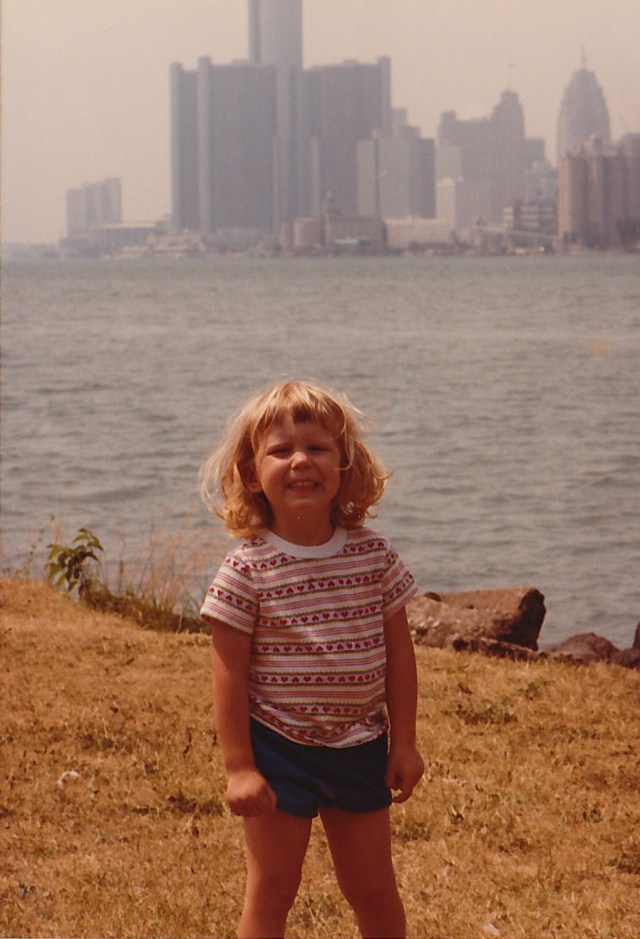
Me on Belle Isle, 1984
Next: Itinerary and Bibliography.
Itinerary
7/22/2015
Dinner: Downtown Disney // Uva Bar // Anaheim, CA
Hotel: Knott’s Berry Farm Hotel // Buena Park, CA
7/23/2015 – Anaheim, CA
Breakfast: Downtown Disney // La Brea Bakery Cafe
- Disneyland
- Disneyland California Great Adventure
7/24/2015 – Las Vegas, NV
Hotel: The Rio // Las Vegas, NV
Dinner: Bacchanal Buffet // Ceasers Palace
7/25/2015
Breakfast: Carnival World Buffet // The Rio // Las Vegas, CA – It was awful. Never eat breakfast here!
- Ghost town @ Frisco, Utah // Frisco, UT
Hotel: Motel 6 // Moab, UT
7/26/2015 – Moab, UT
Coffee: Moab Coffee Roasters
- Kane Creek Blvd. Rock Art Site
- Birthing Scene on Kane Creek Drive
- Moonflower Canyon Rock Art
- Jug Handle Arch Rock Art
- Dinosaur Tracks
Lunch: Jailhouse Cafe
- Island in the Sky District / Canyonlands National Park
- Courthouse Wash Rock Art
Dinner: Peace Tree Juice Cafe
- Arches National Park
7/27/2015
Breakfast: Eklecticafe // Moab, UT
- Sego Canyon, UT
Lunch: CO Ranch House // Glenwood Springs, CO
- Book Train // Glenwood Springs, CO
- Dinosaur Ridge Trail // Morrison, CO
Hotel: Comfort Suites // Castle Rock, CO
7/28/2015
Breakfast: Cookies and Crema // Castle Rock, CO
- Manitou Cliff Dwellings // Colorado Springs, CO
- Poor Richard’s Bookstore // Colorado Springs, CO
Lunch: Rico’s Cafe & Wine Bar // Colorado Springs, CO
Hotel: Best Western Plus Mid-Nebraska Inn & Suites // Kearny, NE
7/29/2015
Breakfast: Perkins // Kearny, NE
Lunch: Kitchen Table // Omaha, NE
Hotel: Designer Inn & Suites // Toledo, IA
Dinner: Wal-Mart // Marshalltown, IA
7/30/2015 – Iowa City, IA
Lunch: Bluebird Diner // Iowa City, IA
- Artifacts (Antiques / Thrift Store)
- Decorum & Modela (Antiques)
- Haunted Bookstore
- Prairie Lights Books
- Daydreams (Comic Books)
- Coralville Park & Devonian Fossil Gorge
Dinner: Pullman Bar & Diner // Iowa City, IA
Hotel: Best Western Inn Canterbury Inn & Suites // Coralville, IA
7/31/2015
Breakfast: Bluebird Diner // Iowa City, IA
Dinner: Cracker Barrel // Benton Harbor, MI
Bibliography:
Binelli, Mark. Detroit City Is the Place To Be: The Afterlife of an American Metropolis. (New York: Picador Press, 2013.)
Carver, Raymond. Ultramarine. (New York, NY: Random House, 1986.)
Didion, Joan. Where I Was From. (New York, NY: Random House, 2003.)
Dunne, John Gregory. “The Humboldt Murders.” Vanity Fair Magazine, 1997.
Florin, Lambert. Ghost Towns of the West. (New York, NY: Promontory Press, 1970.)
Keep, Elmo. “Built for Eternity.” Vice/Motherboard, 2015.
Kerouac, Jack. On The Road: The Original Scrolls. (New York, NY: Penguin Group, 2007.)
Peavy, Linda and Smith, Urusla, Pioneer Women: The Lives of Women On The Frontier. (New York, NY: Smithmark, 1996.)
Solnit, Rebecca. Storming the Gates of Paradise: Landscapes for Politics. (Berekely, CA: University of California Press, 2007.)
Various Authors. The Midwest: A Collection From Harper’s Magazine. (New York, NY: W.H. Smith Publishers. 1991.)
Pages: 1 2 3 4 5See entire article on one page


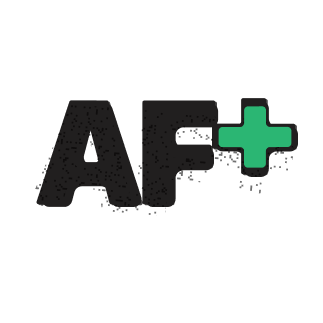
Goddamn.
Amazing. Thank you for sharing this – wishing you all the best as you start to make incredible new memories.
i want to read this every day over and over like it’s a book next to my bed. i’m glad you’re home now
THIS IS SO GREAT I’M SO HAPPY YOU AND ABBY MADE IT HOME
Breathtaking. Thank you for sharing this beautiful reflection!
thank you so much for this riese. i feel like you just shared a bit of your soul with us and i couldn’t be more grateful. truly beautiful.
That was gorgeous. It really felt like I could see the ghosts you were describing in the background of your photos. Thanks for writing this.
This is so utterly beautiful.
I live in NYC now, but I grew up in the southwest. It has always, always seemed weird to me to hear or read what other people have to say as they experience my wide open section of the country. And reading this, I think I finally understand why. My ghosts get in the way of listening to them tell their stories, listening to them verbalize their experiences. It feels foreign to my ghosts, and they push back as these new ideas and new descriptions and new feelings try to occupy the same space, their sacred space. Hearing other people describe my home is always when I feel my listening skills are at their worst, when my mind wanders the most, when mental images are at their sharpest. This was enlightening to read and hopefully I will remember this in the future.
This is brilliant, Riese. Thanks so much for sharing it with us.
I’m someone who can’t stand to hear strangers talk about places I have lived (and yet always seeks out opportunities to do so?), so this strikes a real chord with me. Thank you for putting it into words–I have a lot to think about here.
And yes, Riese, lovely and haunting. Welcome home.
Yes I’m also a person who feels weird hearing people talk about my places but keep seeking it out just the same, and I never really knew why. But yes what you said; that’s exactly it!
I love this. I love how you and Abby beam in your photos together. I LOVE the ghostly collage of photos in front of Cinderella’s Castle. I love the integration of quotes and facts. The description of places being layered with ghosts really resonated with me too.
Tracking down ghosts seems much more effective than running from them. Thank you Riese <3
this is so fucking perfect that i can’t even stand it. i want it to keep going, all across the country and until i fall asleep.
i LOVE this.
This is so beautiful. You are so beautiful.
Thank you for this beautifully honest piece. My favourite thing that I’ve read in a long while.
This was beautiful.
This is so lovely it hurts. And that Beauty and the Beast theory is my new head-canon.
According to this itinerary, you and Abby and I ate at the Cracker Barrel in Benton Harbor on the same day. Only I was moving out of Michigan, to Wisconsin, to live with my girlfriend for the first time.
Okay, that is totally crazy! I hope you had cinnamon apples.
<3
Gahdammit, I just love it when you write stuff like this.
Riese, your feelings about Cracker Barrel have not been a secret for some time. ;)
I’m honestly pretty jealous about that jungle hotel. Especially knowing that the faux-leaves weren’t even dusty.
This was excellent.
I really should be getting commission from the Lima Ohio Cracker Barrel at this point.
Also yeah the whole room was incredibly clean! Id expected it to be sort of shabby and gross but it wasn’t. Much like the actual rainforest, I’m sure.
<3 LOVE LOVE THE PHOTO ESSAY. Writing is always always on point!
Ugh, this stupid essay with stupid love thoughts and stupid Midwestern feelings has given me these stupid tears. Ugh. Ugh. Ugh. Ghosts. Ugh. Feelings. Gross. Cracker Barrel. Ugh. Ugh.
This was wonderful.
Beautiful! Thank you.
This is lovely
I loved this.
This is so interesting and wonderful. You are too.
Riese, absolutely brilliant. I adore this essay. And I find the love and adventure you and Abby have a constant inspiration.
This is perfect. I’m so glad you guys are home and happy. <3
Reading pieces like this always make me feel like I’m curled up on the couch, chatting with an old friend. Absolutely beautiful writing and photographs. I’m so happy for you and Abby :) You look so vibrant and so full of joy in the photos.
I’ve been waiting to read this till I had uninterrupted time and the desktop. It was worth the wait. Thank you.
Beautifully written, so engaging. What a great start to a new phase in both of your lives.
Thank you for sharing this.
Absolutely beautiful! From the start of 2011 to the end of 2014, I lived in 5 different states including both coasts. This captured so many of the feelings I had during all the moves and road trips. I grew up in small town Ohio and landed in Chicago, so I have a lot of feelings about the midwest. This article brought them ALL to the surface. Also, I really want Steak and Shake now, so thanks for that.
Loved reading this Riese. You captured a cross-country move in a really beautiful way. Also, hooray to more midwest Straddlers!
I feel like I just finished a good book. I relate to your feelings about Cracker Barrel so hard. There’s a string of Cracker Barrels off I59 and I20 through Alabama that have all my road trip memories.
I left Michigan for California 18 years ago and I have such bittersweet memories about suburban Detroit n my beloved Ann Arbor. Your writing brings all the good back! And I’m looking forward to reading about all the adventures ahead. It’s kinda my corrective experience to hear about happy queers in the mitten
. Also, the links to the Detroit articles are great. Please keep the coming.
My parents have watched Breaking Bad from beginning to end handfuls of times. My mom says it’s because when she isn’t watching she misses Jesse and has to keep going back for more. I know this is a weird analogy but I sorta feel that way about this piece. Even though you and Abby are people that exist in the real world, and even in MY real world, these characters you just wrote are the kind that now that I’m finished reading about, I’m going to miss. As always, looking forward to your next story.
i loved this. as i build up the courage to finally leave where i am and move somewhere new, reading about these journeys inspires me.
i know that when i am finally ready to leave, i’ll read this again.
i loved your pictures, too.
This is a thing I want to keep close forever and always.
Ugh this was so goddamn good. It makes me want to travel and it makes me want to come home.
I was looking forward to read this and the Goodbye California article for a long time. Now for the special A+ week I upgraded from Cobalt to Bronze and was finally able to do so. I loved it! Always love your writing, it’s something very special. And gorgeous photos!